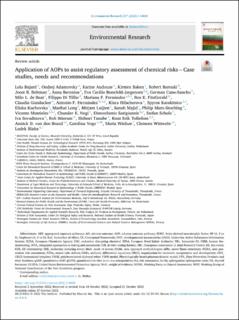| dc.contributor.author | Bajard, Lola | |
| dc.contributor.author | Adamovsky, Ondrej | |
| dc.contributor.author | Audouze, Karine | |
| dc.contributor.author | Baken, Kirsten | |
| dc.contributor.author | Barouki, Robert | |
| dc.contributor.author | Beltman, Joost B. | |
| dc.contributor.author | Beronius, Anna | |
| dc.contributor.author | Bonefeld-Jørgensen, Eva Cecilie | |
| dc.contributor.author | Cano-Sancho, German | |
| dc.contributor.author | de Baat, Milo L. | |
| dc.contributor.author | Di Tillio, Filippo | |
| dc.contributor.author | Fernandez, Mariana F. | |
| dc.contributor.author | FitzGerald, Rex E. | |
| dc.contributor.author | Gundacker, Claudia | |
| dc.contributor.author | Hernández, Antonio F. | |
| dc.contributor.author | Hilscherova, Klara | |
| dc.contributor.author | Karakitsios, Spyros | |
| dc.contributor.author | Kuchovska, Eliska | |
| dc.contributor.author | Long, Manhai | |
| dc.contributor.author | Luijten, Mirjam | |
| dc.contributor.author | Majid, Sanah | |
| dc.contributor.author | Marx-Stoelting, Philip | |
| dc.contributor.author | Mustieles, Vicente | |
| dc.contributor.author | Negi, Chander K. | |
| dc.contributor.author | Sarigiannis, Dimosthenis | |
| dc.contributor.author | Scholz, Stefan | |
| dc.contributor.author | Sovadinova, Iva | |
| dc.contributor.author | Stierum, Rob | |
| dc.contributor.author | Tanabe, Shihori | |
| dc.contributor.author | Tollefsen, Knut-Erik | |
| dc.contributor.author | van den Brand, Annick D. | |
| dc.contributor.author | Vogs, Carolina | |
| dc.contributor.author | Wielsøe, Maria | |
| dc.contributor.author | Wittwehr, Clemens | |
| dc.contributor.author | Blaha, Ludek | |
| dc.date.accessioned | 2023-03-20T14:25:38Z | |
| dc.date.available | 2023-03-20T14:25:38Z | |
| dc.date.created | 2023-02-21T09:15:31Z | |
| dc.date.issued | 2022 | |
| dc.identifier.citation | Environmental Research. 2022, 217, 114650. | en_US |
| dc.identifier.issn | 0013-9351 | |
| dc.identifier.uri | https://hdl.handle.net/11250/3059352 | |
| dc.description.abstract | While human regulatory risk assessment (RA) still largely relies on animal studies, new approach methodologies (NAMs) based on in vitro, in silico or non-mammalian alternative models are increasingly used to evaluate chemical hazards. Moreover, human epidemiological studies with biomarkers of effect (BoE) also play an invaluable role in identifying health effects associated with chemical exposures. To move towards the next generation risk assessment (NGRA), it is therefore crucial to establish bridges between NAMs and standard approaches, and to establish processes for increasing mechanistically-based biological plausibility in human studies. The Adverse Outcome Pathway (AOP) framework constitutes an important tool to address these needs but, despite a significant increase in knowledge and awareness, the use of AOPs in chemical RA remains limited. The objective of this paper is to address issues related to using AOPs in a regulatory context from various perspectives as it was discussed in a workshop organized within the European Union partnerships HBM4EU and PARC in spring 2022. The paper presents examples where the AOP framework has been proven useful for the human RA process, particularly in hazard prioritization and characterization, in integrated approaches to testing and assessment (IATA), and in the identification and validation of BoE in epidemiological studies. Nevertheless, several limitations were identified that hinder the optimal usability and acceptance of AOPs by the regulatory community including the lack of quantitative information on response-response relationships and of efficient ways to map chemical data (exposure and toxicity) onto AOPs. The paper summarizes suggestions, ongoing initiatives and third-party tools that may help to overcome these obstacles and thus assure better implementation of AOPs in the NGRA. | en_US |
| dc.language.iso | eng | en_US |
| dc.publisher | Elsevier | en_US |
| dc.rights | Navngivelse-Ikkekommersiell 4.0 Internasjonal | * |
| dc.rights.uri | http://creativecommons.org/licenses/by-nc/4.0/deed.no | * |
| dc.title | Application of AOPs to assist regulatory assessment of chemical risks – Case studies, needs and recommendations | en_US |
| dc.type | Peer reviewed | en_US |
| dc.type | Journal article | en_US |
| dc.description.version | publishedVersion | en_US |
| dc.rights.holder | © 2022 The Authors | en_US |
| dc.source.pagenumber | 16 | en_US |
| dc.source.volume | 217 | en_US |
| dc.source.journal | Environmental Research | en_US |
| dc.identifier.doi | 10.1016/j.envres.2022.114650 | |
| dc.identifier.cristin | 2127732 | |
| dc.source.articlenumber | 114650 | en_US |
| cristin.ispublished | true | |
| cristin.fulltext | original | |
| cristin.qualitycode | 2 | |

